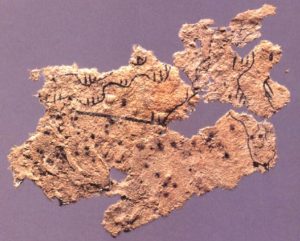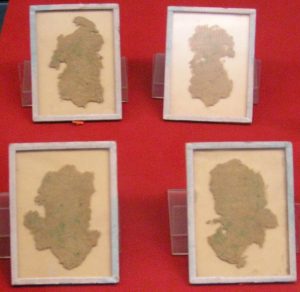While papyrus , opens a new windowwas still king in Egypt and Europe, another medium was being invented in China―paper, opens a new window. What separates "true" paper from the papyrus and parchment that came before it is that it is made up of fiber. Paper has been made from asparagus stalks, bark, cactus, cotton, ivory, leather, linen, manure, moss, nettles, peat, pollen, potatoes, rhubarb, satin, seaweed, straw, sugar cane, tobacco, thistles, wood pulp, wool, and more.
Throughout much of Chinese history, a servant named Cai Lun was credited with creating paper in 105 CE. He made his paper out of the inner bark of the chu tree (a mulberry-like tree), hemp, rags, and rope from old fishing nets. He pounded and sieved the materials in a pool in his backyard, then pressed and dried them in the sun.
However, archaeologists have found paper fragments in China dating back to the first and second centuries BCE. A bamboo tablet has been found and dated to 217 BCE that describes the transformation of hemp to paper.
To learn more about the invention of paper and its history, visit the "Reading the World: Tablet to Tablet" exhibit at the Mandeville Branch all November long! For even more information about paper and how to make it, check out one of these titles from the St. Tammany Parish Library:





Add a comment to: Tablet to Tablet: Paper!